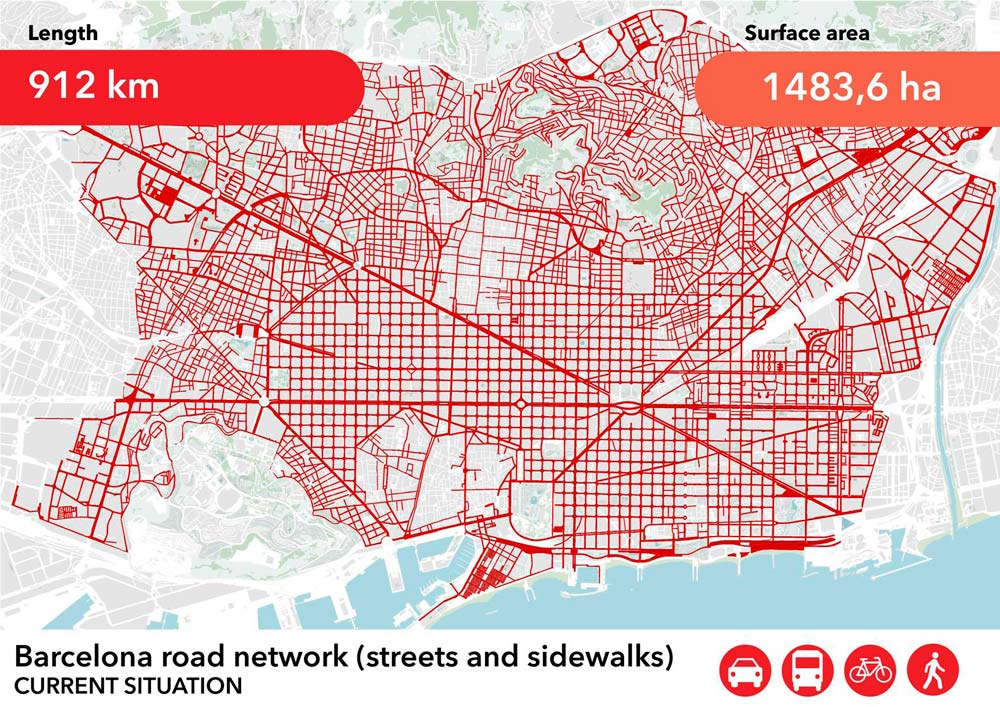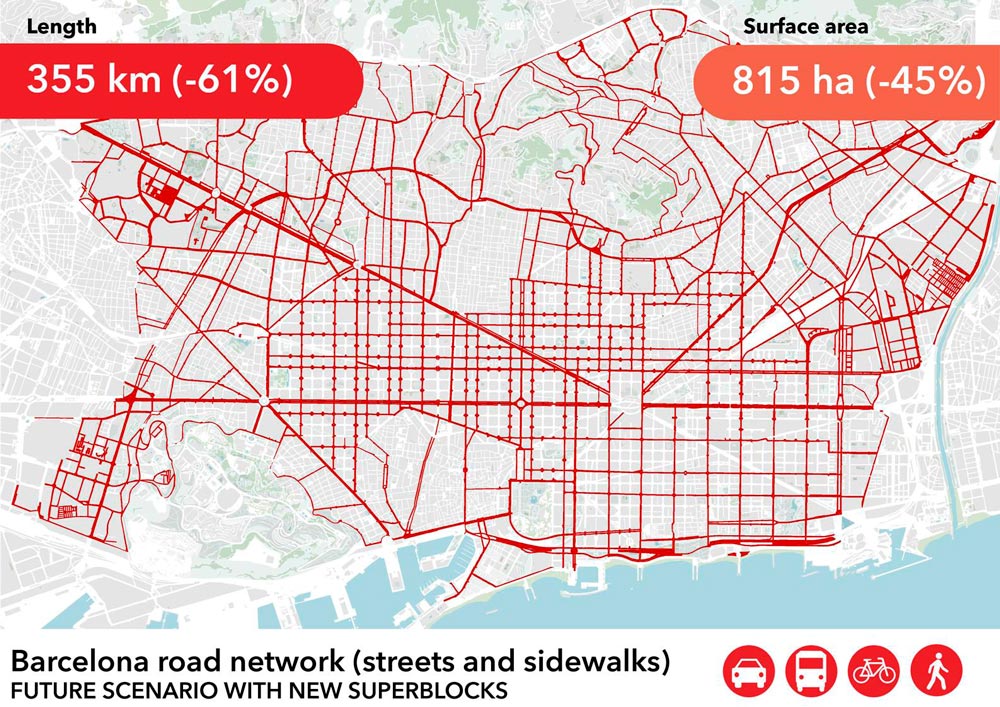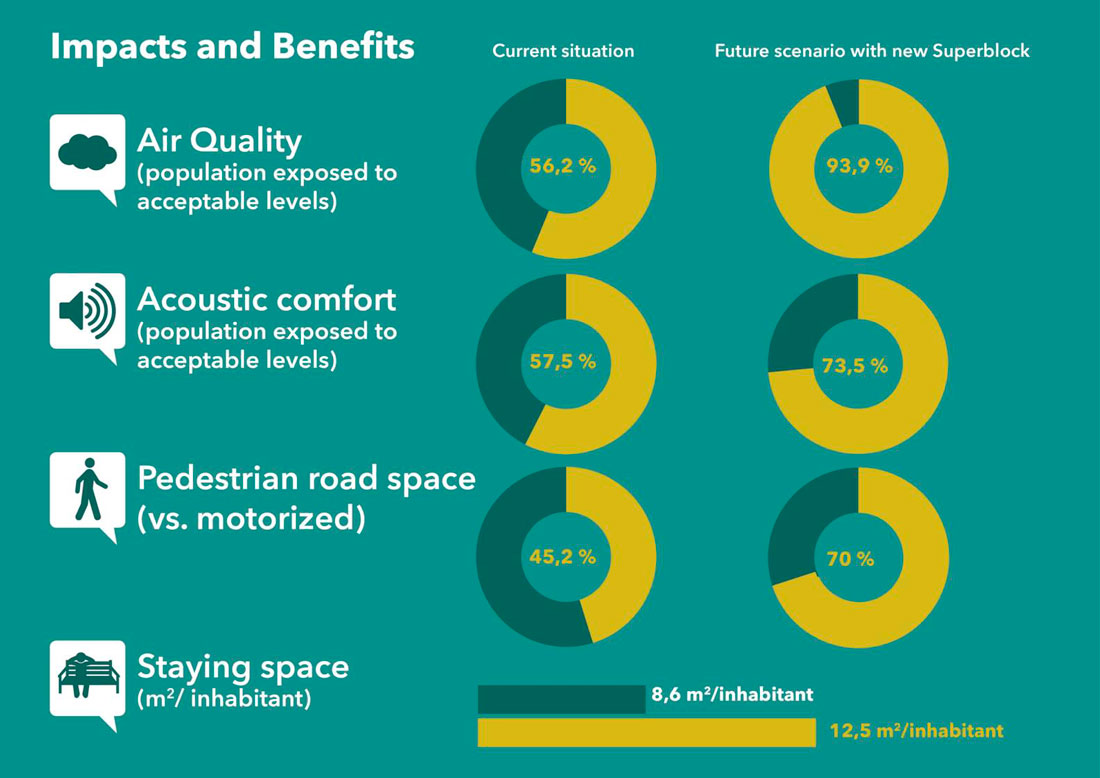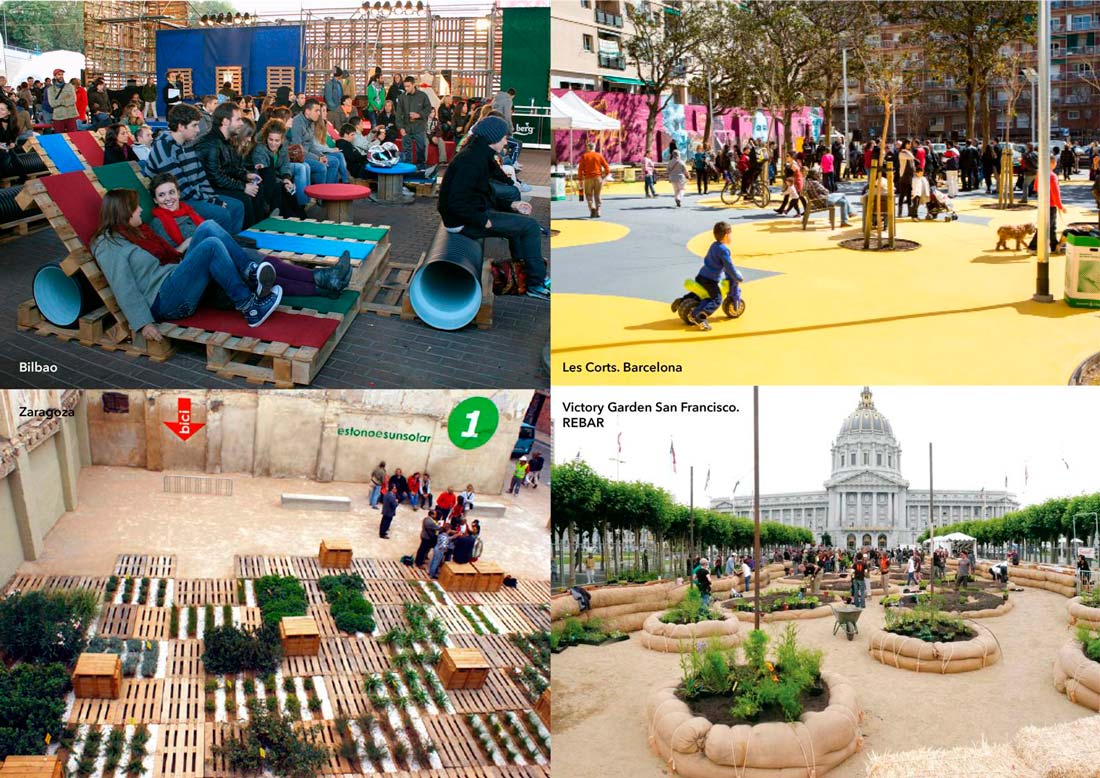The fact that quality of life is deteriorating in numerous cities all over the world and urban systems are having an impact on our planet’s ecosystems means that we must change how we currently create cities and the bases underpinning change processes. A new theoretical and instrumental framework must be established for designing new urban developments and above all, the regeneration of existing ones. Urban ecology is a discipline which has a necessary theoretical framework for facing the urban reality holistically and systemically and it is the only discipline which can harmonise urban transformation processes with the laws of nature.
This Charter considers cities to be ecosystems, the most complex ecosystem created by humans. When we face this complexity and equally try to reduce the level of urban deterioration and the level of impact on support systems, we must define an intentional urban model with an impact on the essential features of the urban dynamic which also confronts the sustainability challenges in the information age, which are essential for reducing uncertainties and increasing our capacity for foresight. The only urban model which fulfills all the requirements is morphologically compact, complex in terms of anthropic and biologic organisation, metabolically efficient and socially cohesive. For the implementation of urban models, a new urban instrument is required: ecosystem urbanism. This takes all the variables of the wider context into account within the urban planning process. It proposes producing cities and is against generating suburbs. It establishes a set of principles defining the rules of engagement and the system of restrictions making up the intentional urban model which are a practical guide for production processes within new cities and regeneration of existing ones.
Morphologically, we are looking for urban uses and functions which use as little land as possible. We are supporting regeneration and recycling of existing fabrics and only using new land when absolutely necessary. This compactness must foster the critical mass of the population and legal persons to sufficiently create a city, so there is public space and a mix of uses. The proximity and critical mass allow access on foot to basic services and equipment, in addition to making public transport viable. Density must endeavour to create a city, but must not exceed specified thresholds in order to create an equilibrium city with sufficient spaces for decompression, elevated biodiversity values, public spaces with sufficient insulation spaces and a specified level of energy self-sufficiency, etc.
Urban functionality is defined by the current mobility model based on motorised modes. This model is the largest energy consumer, conditions the use of public spaces (more than 80% of public roads are used for mobility) and creates the worst urban dysfunctions (contamination, noise, etc.) with impacts on health and the environment. Reducing these current dysfunctions and freeing up space predominantly used for public mobility means changing the mobility model to one based on alternative methods of transport, other than cars. The planning instrument to change this mobility model, while guaranteeing system functioning, is the superblock. Superblocks will favour, in this order, movement on foot, public transport and bicycles. Mobility will no longer be a service and will progress towards electric vehicles; the use of electric bikes will be favoured over electric cars.
Freeing up space will be achieved by implanting superblocks throughout the entire city, which allows to reduce current dysfunctions and control variables providing habitability within public spaces. Improvement of air quality, sound reduction, safety, temperature comfort, accessibility etc. will create conditions conducive to a significant increase in the number and diversity of legal persons. Freeing up public space enhances citizen uses and rights to be exercised in the public space. The right to movement, which is currently a dominant and almost unique right, will additionally give way to the right to exchange, leisure, culture and political expression. The opportunity to exercise all these rights in a public space, a “shared house”, makes us citizens. Today, the mobility model restricts these rights and our main goal is to promote walking as a method of transport. Enhancing these uses and rights will turn streets into squares. By implanting superblocks, 70% of public spaces are freed up giving us more of an active role to become citizens, citizens who mainly will travel on foot.
The city is supported by its organisations, which are also known as legal persons. In urban systems, entities which are not organisations are irrelevant. Each legal person has, at least, one intention justifying it and allowing it to relate to other legal persons. These entities treasure useful information, that is, knowledge. The abundance and diversity of legal persons determine the complexity of the network of relationships. This network is the competitive base between regions and the one that determines, following the Margalef principle, the relative position of each urban system in the national and international order of cities and metropolises.
The current strategy for competition between urban systems based on the consumption of resources is a huge threat to the future of humanity. The only hopeful strategy is based on increasing the number (n) and diversity (H) of legal persons in general and especially of knowledge-dense legal persons, while drastically reducing consumption of natural resources (E). This strategy uses nature to enhance viability of living beings and ecosystems, to increase organised complexity and at the same time reduce the necessary energy for maintaining this complexity. The E/nH ratio that reduces over the time axis indicates the path to follow, and suggests a strategic shift towards competition based on information and knowledge, sustained by services and a less material economy. This is the equation that deals with sustainability challenges in the information age.
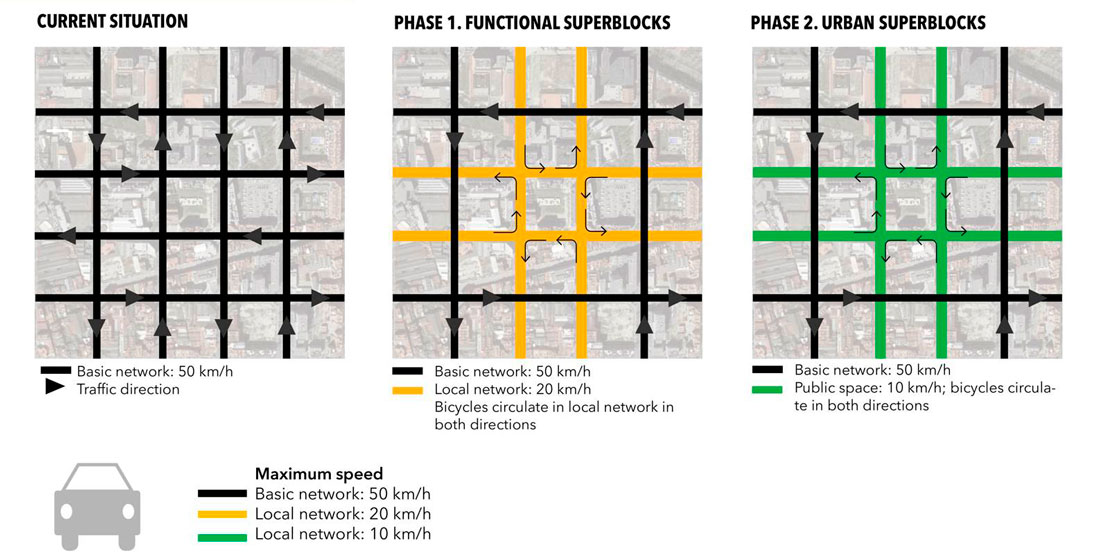 Road hierarchy for private vehicles
Road hierarchy for private vehicles
Using a strategy based on information and knowledge, urban planning must enhance growth of n and H, promoting new central areas, densification and mixture of suburb uses, activities taking place at a height when there are neighbourhoods made up of tower buildings, corridor streets full of related activities, etc. The increase of n and H increases the number of jobs, employment self-restraint and self-sufficiency, ensuring the existence of basic services for residents.
Knowledge-dense legal persons hoard the majority of useful information, acting as the base for the city knowledge or the “smart city” model. The number and diversity of knowledge-dense legal persons increases as the strategy for increasing information flows and hyperconnectivity grows. This is also done through implementing actions on the necessary sector plans for achieving the principles of ecosystemic urbanism.
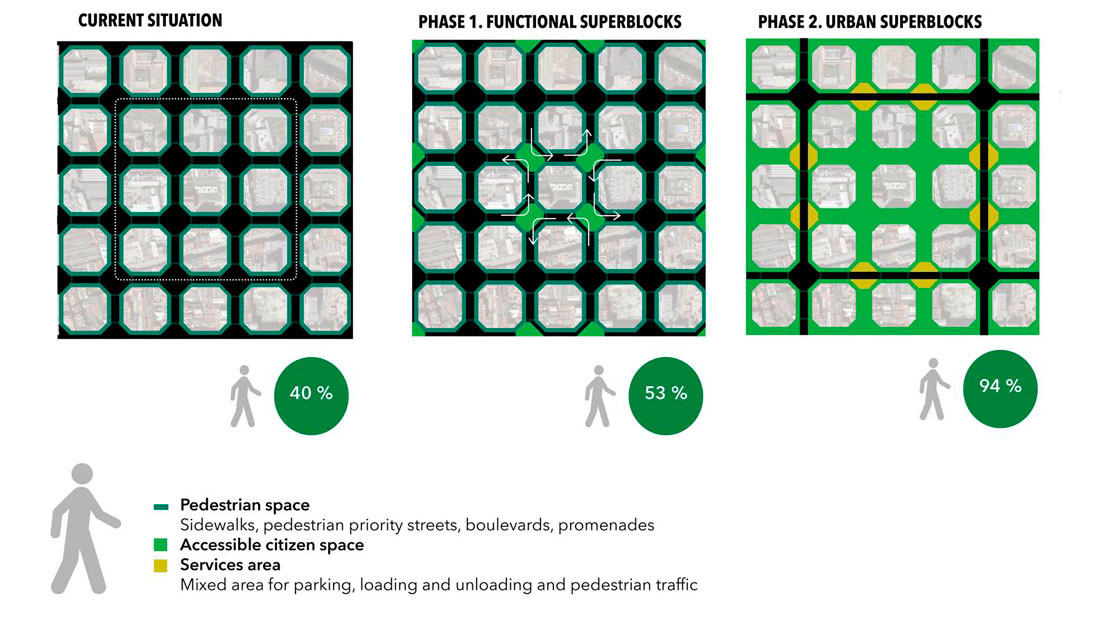 Pedestrians
Pedestrians
We will consider the biophysical matrix as one of the structural elements for urban planning, creating a connected ecological matrix that increases biodiversity and strengthens and re-evaluates peri-urban agriculture and its productivity. The extensive and continuous network of green and blue metropolitan spaces will penetrate the urban system, creating green corridors using the extensions of these areas that have least resistance to the penetration of biodiversity. The green network will be completed by planting vegetation in part of the space freed up by superblocks and in these opportunity spaces: interior block patios, obsolete industry, abandoned spaces, green roofs and walls, etc. Planning on the biophysical matrix must help to close material and water cycles.
Urban ecosystems are open systems in terms of materials, energy and information. They are heterotrophic systems which need resource entry flows and waste exit flows to maintain their organisation. Ecosystemic urbanism seeks to achieve the best efficiency possible for each of the metabolic vectors and the best self-sufficiency with local and renewable resources. It is equally seeking to reduce the minimum amount of impacts on the environment and people. This attempt is combined with the mitigation of and adaptation to climate change, with the aim of foreseeing problems associated with this phenomenon. Again, superblocks play a fundamental role both for mitigation of and adaptation to climate change, as well as to achieve metabolic efficiency targets and closing biogenic cycles.
 Rethinking urban public space: moving from linear and uni-purpose to dynamic spaces with diverse uses
Rethinking urban public space: moving from linear and uni-purpose to dynamic spaces with diverse uses
In urban ecosystems, people are the main component. Numerous factors, among them urbanism, have been responsible for the level of social exclusion and inequality that the majority of cities throughout the world display today. The level of marginalisation and absolute poverty which almost a thousand millions of citizens in the world’s cities have to endure is not remotely acceptable. Quality of life and coexistence suffer, even for those who have most, and people often become isolated and scared “to death”. The “adequate” mix of people of a different social condition and backgrounds living in proximity, possibly in the same building, has been proven as the best solution for coexistence and individual and collective growth. Urban formulas for mixing incomes, ages, ethnicities, etc. are essential for social cohesion. In this section, it is essential that the State acts where the market does not. Everyone has the right to decent housing and close facilities conducive to urban habitability. Providing primary care services has an adequate territorial framework within superblocks.
The principles of ecosystemic urbanism are articulated integrally and systemically; in order to achieve these principles, superblocks and the definition of three planes with corresponding land reserves are two of the fundamental technical instruments.
The theoretical and technical framework needs regulatory, economic-financial, organisational, governance, educational and training instruments.
The legal framework for each urban reality is different. A lot of current legislation means that the proposals included in this document cannot be included. The challenges we are facing do not leave any margin for hesitation and it is necessary to adapt the regulatory framework to the objectives and principles expressed.
The economic effort of government to implement the Charter’s proposals is considerable for some of the principles, for example the acquisition of housing stock in order to achieve social mixes not provided by the market. The budgets that the State raises and then provides to municipalities are, in the majority of cases, very small, even though cities generate 80% of the GDP. It seems reasonable current budget scenario must be changed, particularly in the knowledge that the future depends on how we organise our cities from here on.
For concrete fulfillment of the initiatives necessary for reaching the stated objectives, purpose-driven tax policies have always proven to be very effective.
The position of cities for making decisions on an international scale is insignificant. While the relative position of urban systems does not correspond to their size and importance, it is going to be difficult to reach the goals to reduce current uncertainties and alleviate the current level of urban and social deterioration. In the same way, it is going to be impossible to enact significant change without active participation from citizens and institutions on all scales.
It is fundamental that citizens take ownership of their own existence to change current lifestyles. New lifestyles confront the challenges of sustainability in the information age. The new age must define a new paradigm, away from the principles assumed during the industrial era, which have caused the scenario of current instability. Educational and training efforts must be huge, as much as the change we urgently need.
